
Millets are a group of highly variable small-seeded grasses, widely grown around the world as cereal crops or grains for fodder and human food.

Sorghum is a genus of about 25 species of flowering plants in the grass family Poaceae. Some of these species have grown as cereals for human consumption and some in pastures for animals. One species, Sorghum bicolor, was originally domesticated in Africa and has since spread throughout the globe. Seventeen of the 25 species are native to Australia, with the range of some extending to Africa, Asia, Mesoamerica, and certain islands in the Indian and Pacific Oceans. One species is grown for grain, while many others are used as fodder plants, either cultivated in warm climates worldwide or naturalized in pasture lands. Sorghum is in the subfamily Panicoideae and the tribe Andropogoneae.

Forage is a plant material eaten by grazing livestock. Historically, the term forage has meant only plants eaten by the animals directly as pasture, crop residue, or immature cereal crops, but it is also used more loosely to include similar plants cut for fodder and carried to the animals, especially as hay or silage. The term forage fish refers to small schooling fish that are preyed on by larger aquatic animals.
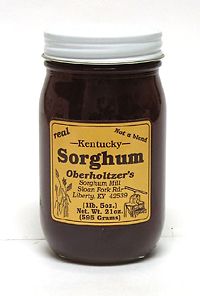
Sweet sorghum is any of the many varieties of the sorghum grass whose stalks have a high sugar content. Sweet sorghum thrives better under drier and warmer conditions than many other crops and is grown primarily for forage, silage, and syrup production.
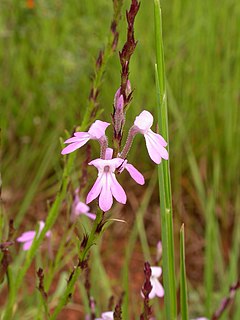
Striga, commonly known as witchweed, is a genus of parasitic plants that occur naturally in parts of Africa, Asia, and Australia. It is in the family Orobanchaceae. Some species are serious pathogens of cereal crops, with the greatest effects being in savanna agriculture in Africa. It also causes considerable crop losses in other regions, including other tropical and subtropical crops in its native range and in the Americas.

Holcus is a genus of African and Eurasian plants in the oat tribe within the grass family.

Johnson grass or Johnsongrass, Sorghum halepense, is a plant in the grass family, Poaceae, native to Asia and northern Africa. The plant has been introduced to all continents except Antarctica, and most larger islands and archipelagos. It reproduces by rhizomes and seeds.

Sorghum bicolor, commonly called sorghum and also known as great millet, durra, jowari / jowar, or milo, is a grass species cultivated for its grain, which is used for food for humans, animal feed, and ethanol production. Sorghum originated in Africa, and is now cultivated widely in tropical and subtropical regions. Sorghum is the world's fifth-most important cereal crop after rice, wheat, maize, and barley, with 59.34 million metric tons of annual global production in 2018. S. bicolor is typically an annual, but some cultivars are perennial. It grows in clumps that may reach over 4 m high. The grain is small, ranging from 2 to 4 mm in diameter. Sweet sorghums are sorghum cultivars that are primarily grown for forage, syrup production, and ethanol; they are taller than those grown for grain.
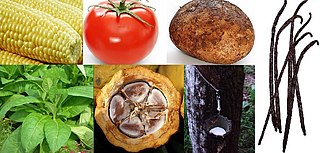
A crop is a plant or animal product that can be grown and harvested extensively for profit or subsistence. Crops may refer either to the harvested parts or to the harvest in a more refined state. Most crops are cultivated in agriculture or aquaculture. A crop may include macroscopic fungus, or alga.

Biofuel is fuel that is produced from organic matter (biomass), including plant materials and animal waste. It is considered a renewable source of energy that can assist in reducing carbon emissions. The two main types of biofuel currently being produced in Australia are biodiesel and bioethanol, used as replacements for diesel and petrol (gasoline) respectively. As of 2017 Australia is a relatively small producer of biofuels, accounting for 0.2% of world bioethanol production and 0.1% of world biodiesel production.

Commercial sorghum is the cultivation and commercial exploitation of species of grasses within the genus Sorghum. These plants are used for grain, fibre and fodder. The plants are cultivated in warmer climates worldwide. Commercial Sorghum species are native to tropical and subtropical regions of Africa and Asia.

Ascochyta sorghi is a fungal plant pathogen. It causes Ascochyta leaf spot on barley that can also be caused by the related fungi Ascochyta hordei, Ascochyta graminea and Ascochyta tritici. It is considered a minor disease of barley.
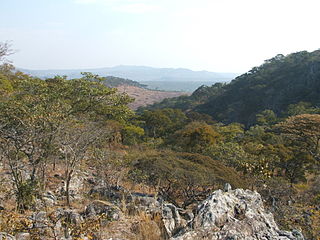
Chitemene, from the ciBemba word meaning “place where branches have been cut for a garden”, is a system of slash and burn agriculture practiced throughout northern Zambia. It involves coppicing or pollarding of standing trees in a primary or secondary growth Miombo woodland, stacking of the cut biomass, and eventual burning of the cut biomass in order to create a thicker layer of ash than would be possible with in situ burning. Crops such as maize, finger millet, sorghum, or cassava are then planted in the burned area.

The 3-Deoxyanthocyanidins and their glycosides are molecules with an anthocyanidins backbone lacking an hydroxyl group at position 3 on the C-ring. This nomenclature is the inverse of that which is commonly used in flavonoids, where the hydroxy-group is assumed absent if it is not specified, e. g. flavan-3-ol, flavan-4-ol, flavan-3,4-ol and flavonol.

The Angoumois grain moth is a species of gelechioid moth. It is the type species of its genus Sitotroga, placed in the subfamily Pexicopiinae of the twirler moth family (Gelechiidae). Formerly, it was included in the "Chelariinae", which more recent authors do not separate from the Pexicopiinae and usually even do not consider a distinct tribe ("Chelariini") within them.
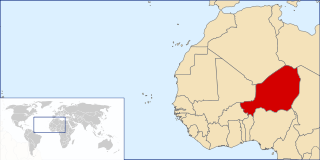
The cuisine of Niger draws on traditional African cuisines. Various spices are used and meals include grilled meat, seasonal vegetables, salads, and various sauces are some of the foods consumed. Meals in Niger usually start with colorful salads made from seasonal vegetables. Moringa leaves are a favorite for a salad. Typical Nigerien meals consist of a starch paired with a sauce or stew. The starches eaten most often are millet and rice. Staple foods include millet, rice, cassava, sorghum, maize and beans. Couscous is saved for special occasions. Porridge, wheat dumplings, and beignets are some of Niger's popular snacks.
Sorghum timorense, commonly known as Downs sorghum, is an annual tropical Asian and Australasian grass native to the island of Timor, and Australia in the northern portions of the states of Northern Territory, Queensland, and Western Australia.
Tyrosine N-monooxygenase (EC 1.14.13.41, tyrosine N-hydroxylase, CYP79A1) is an enzyme with systematic name L-tyrosine,NADPH:oxygen oxidoreductase (N-hydroxylating). This enzyme catalyses the following chemical reaction

Red Sorghum is a 2014 Chinese television series based on Nobel laureate Mo Yan's 1986 novel of the same name. Directed by Zheng Xiaolong, it also features the highly anticipated return of actress Zhou Xun to television after 10 years. The series chronicles the struggles of the protagonist Jiu'er in rural Shandong province in early 1930s. It aired simultaneously on four satellite television channels from 27 October to 17 November 2014 for 60 episodes.

A staple food, food staple, or simply a staple, is a food that is eaten routinely and in such quantities that it constitutes a dominant portion of a standard diet for a given people, supplying a large fraction of energy needs and generally forming a significant proportion of the intake of other nutrients as well. A staple food of a specific society may be eaten as often as every day or every meal, and most people live on a diet based on just a small number of food staples. Specific staples vary from place to place, but typically are inexpensive or readily available foods that supply one or more of the macronutrients needed for survival and health: carbohydrates, proteins, fats, minerals, and vitamins. Typical examples include tubers and roots, grains, legumes, and seeds. Among them, cereals, legumes, tubers and roots account for about 90% of the world's food calories intake.

















